Why Case Management?
Business Process Management becomes more and more important. With BPM Suite processes can be modeled, implemented, simulated and executed in a multi-user environment. There are also a lot of different reports available to monitor processes during runtime. We see in our projects, that this kind of automation is especially valuable for processes which are based on routine work. Some examples are “Hiring”, “Order-to-Cash”, “Order Management”, “Travel Request Management” and so on.
However - we also notice quite a high amount of processes, which are too complex and too flexible to model them in BPMN. We call it knowledge-intensive work. Of course if you have a lot of time you might be able to model almost everything but is it a benefit to have processes which are not readable anymore? How fast is your time-to-market? How easy is it to implement process changes? How can you support the job of the knowledge worker? Some typical domains with a high amount of knowledge-intensive work are Insurances, Banks, Healthcare, Civil Services and Government Agencies.
Let me try to explain the need of case management with our RYLC example. RYLC stands for “Rent your legacy car” and it was introduced in a series of articles as an overall solution example. The main target of RYLC was to explain concepts like service categories, loose coupling, canonical data model, service security and much more (see SOA Spezial magazine for details). The graphic below shows the complete End-to-End RYLC process in BPMN notation from receiving the request, selection of the car, checkout of the vehicle, returning it, creation of the invoice and cash clearance. I highlighted the checkin-part of the process, which covers the return of the car. It is based on an asynchronous message exchange pattern - the process execution stops until the checkin is completed or canceled. In this stage several things can happen.
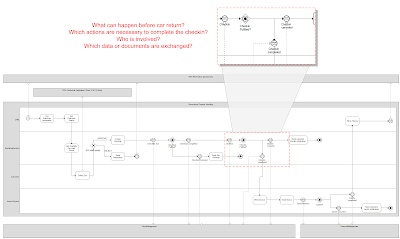 |
| BPMN Example - Rent your legacy car (RYLC) |
A lot of effort and time is necessary to bring all the mentioned varieties into the process. Examples like an accident will result in claim notifications and extended communication with the appropriate insurances. It is difficult to model each potential option. This is where Case Management comes into the game. It helps us to combine different milestones with the appropriate task actions, business rules, stakeholders, resulting events as well as data and documents (see the image below). During the car-checkin different milestones like “In Rental”, “Accident” (optional), “Stolen” (optional), “Returned” and “Approved” might occur. Each milestone consists of mandatory and optional task actions. Their execution order is defined by business rules. The task actions can be system driven (implemented as services) or user driven. Of course similar to BPMN some data and documents are exchanged in each step. Case Management is mainly controlled by the knowledge worker, which means that they affect the “flow” of the case. Therefore the definition of stakeholders and their permissions is another important aspect. Some example stakeholders in RYLC are the insurance holder, driver, car park assistant, front desk clerk and the rental manager. Based on the milestones and the task actions different events can occur that trigger new situations. Case management can support the knowledge worker with the right information (but the knowledge worker keeps the decision & process authority). Better and faster process decisions are the benefits of it.
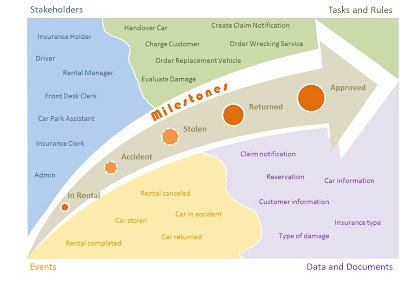 |
| Key aspects in Case Management |
How-to define a Case in Oracle BPM Suite?
In Oracle BPM Suite 11.1.1.7 the Case component is introduced as a first class artifact with support for milestones, events, adhoc activities stakeholders and so on. Like BPMN, BPEL, Human Task, Rules, etc. a Case can be created by just dropping it on the composite level. After completing the wizard a case component, a business rule component and an interface (exposed service) is visible (as illustrated in the image below).
 |
| Composite.xml with Case component |
 |
| Definition of a Case |
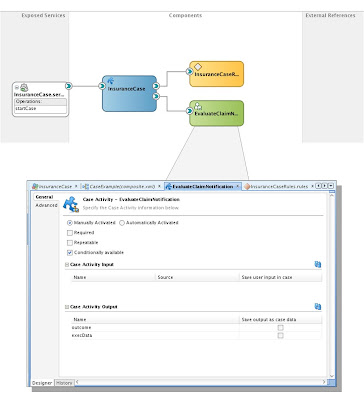 |
| Definition of a Case Activity |
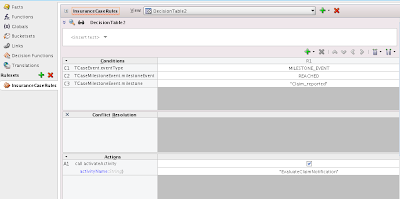 |
| Definition of a Case Rule |
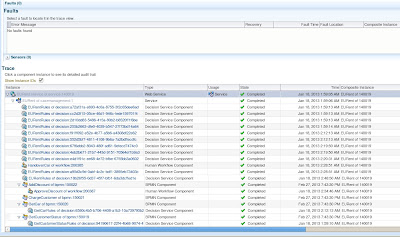 |
| Monitoring of Case instances in EM |
Such as a knowledgeable post.very very useful post. all tips are really important.well Business Process Management System, is going higher and higher in their reputation.really it will help us to keep in competitions.
ReplyDeleteCustom Software Development, Offshore Software Development, Open Source Development, Web Design & Development Services, Software Testing, Technical Maintenance and Support services
ReplyDeleteThis is very elegant blog with great & significant information.Palm beach Website Design
ReplyDeleteIn the past month I already had the chance to play a bit with the beta software. With this post I’d like to share some of my experiences. case management software
ReplyDeleteIs there a difference between case management software and human services software? Or are they pretty much the same thing?
ReplyDeleteI have spent a lot of the time in different blogs but this is really a unique blog for me.case management software
ReplyDeleteQUANTUM BINARY SIGNALS
ReplyDeleteGet professional trading signals sent to your mobile phone every day.
Start following our signals right now and gain up to 270% daily.
It is very good blog and useful for students and developer , Thanks for sharing
ReplyDeleteOracle SOA Online Training
ReplyDeleteThanks for sharing nice information with us. I like your post and all you share with us is up to date and quite informative,
Thanks
Cpa offers
This is often terribly helpful for a freshman. I just put this article in your favorites for future reference. Keep sharing this type of message. Thank you for sharing. Good reading. Thank you for the information. It helps us.
ReplyDeleteDedicatedHosting4u.com
Great, thanks for sharing this post.Much thanks again. Awesome.
ReplyDeletesalesforce training
salesforce online training
Investigative journalism relies heavily on articles to uncover hidden truths and expose corruption or misconduct. Track SERP Performance Through diligent research, journalists shed light on important societal topic.
ReplyDelete